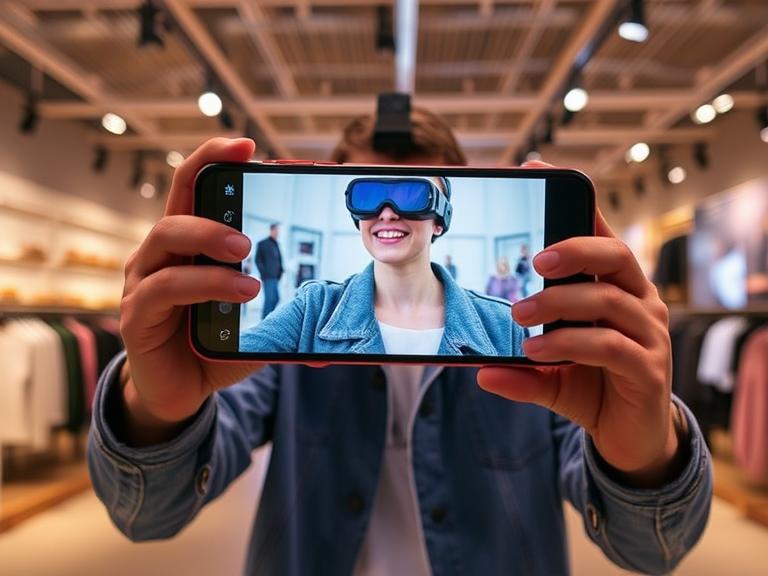In 2025, marketing isn’t just something consumers see — it’s something they experience.
Immersive marketing uses cutting-edge technologies like Augmented Reality (AR), Virtual Reality (VR), and Artificial Intelligence (AI) to create interactive, multisensory brand encounters.
Instead of passively watching ads, customers step into branded worlds, try products virtually, join interactive events, and connect with stories in ways that feel personal, engaging, and unforgettable.
From AR try-ons in beauty apps to virtual product launches in the metaverse, brands are moving beyond telling a story — they’re inviting consumers to live it.
What Is Immersive Marketing?
Immersive marketing blends emerging technology with creative storytelling to pull audiences into the brand experience.
It’s participatory by design — customers interact, explore, and customize in real time.
- AR lets shoppers virtually try on clothes, makeup, or accessories from anywhere.
- VR transports them into fully realized digital environments for product demos, brand experiences, or events.
- AI personalizes these encounters, adapting content instantly to a user’s preferences and behavior.
The goal? Replace one-way messaging with experiences that are felt, remembered, and shared.
AR Try-Ons: Try Before You Buy — Virtually
Augmented reality try-ons are redefining product exploration. Using smartphone cameras or app-based experiences, consumers can see exactly how a product looks or works without ever touching it.
Why it works:
- Increases buying confidence by removing uncertainty
- Adds an interactive, gamified layer to online shopping
- Encourages social sharing — boosting organic reach
Example:
L’Oréal combines AI-powered beauty consultations with AR try-ons, offering custom product recommendations that update in real time based on skin tone, style, and preferences. This creates an engaging, confidence-boosting path to purchase.
Virtual Events: Global Reach, Zero Boundaries
Virtual events have become a cornerstone of immersive marketing, offering interactive experiences without geographic constraints. These can include:
- Virtual showrooms where customers explore product lines in 3D
- Interactive brand activations with gamified challenges and rewards
- Live Q&A sessions with designers, engineers, or influencers
Example:
Mitsubishi’s Amazon Live Virtual Reveal allowed viewers to interact directly with product experts, ask questions in real time, and explore features via dynamic, clickable video — all from their living rooms.
Immersive Brand Storytelling
The real magic of immersive marketing lies in storytelling. Instead of showing a brand’s values, history, or mission, you let customers experience them.
- VR environments can take users behind the scenes of sustainable manufacturing
- AR overlays can animate a product’s journey from concept to creation
- Interactive timelines can let users “choose their path” through brand milestones
Example:
A heritage fashion brand could invite customers into a VR recreation of its first atelier, letting them handle virtual fabric swatches, hear founder stories, and watch iconic pieces come to life.
Why Immersive Marketing Works
Immersive campaigns don’t just stand out — they stick. Key benefits include:
- Enhanced Engagement: Multi-sensory experiences capture attention longer than static ads.
- Emotional Connection: Personalized, participatory moments build loyalty and trust.
- Shareability: Unique, interactive content naturally fuels organic reach.
- Data Insights: AR/VR platforms collect rich behavioral data to refine future campaigns.
Immersive Marketing in Action—2025 Highlights
- L’Oréal’s AI + AR Beauty Experience
Virtual try-ons paired with personalized makeup consultations, turning online shopping into an interactive beauty counter. - Nike’s Foot Scanning App
Smartphone scans generate exact fit recommendations, integrated with a virtual assistant for personalized product suggestions. - Škoda’s “Skodaverse”
AR-enhanced merchandising tied to NFTs offering real-world perks, merging digital loyalty with physical rewards. - Beetles Gel Polish Virtual Manicure
AR-based nail polish previews directly from the brand’s e-commerce site. - Mitsubishi’s Interactive Launch
A VR-style reveal streamed on Amazon Live, merging entertainment with real-time audience engagement.
Emerging Trends Shaping Immersive Marketing
- AI-Driven Personalization in AR/VR
Hyper-custom experiences that adapt instantly to user reactions and preferences. - Metaverse Storefronts & Branded Worlds
Persistent virtual spaces where customers can interact with products and communities. - Hybrid Retail Experiences
Physical pop-ups enhanced with AR layers, interactive walls, and VR demo stations. - Multi-Sensory Storytelling
Incorporating sound design, haptics, and even scent into digital campaigns for richer experiences.
The Bottom Line
Immersive marketing marks a shift from telling customers about a product to letting them experience it firsthand. It’s participatory, personal, and powered by technology — but its impact comes from emotional connection, not just novelty.
Brands that adopt these methods in 2025 aren’t just selling products — they’re crafting moments customers will remember, talk about, and return to again and again.

